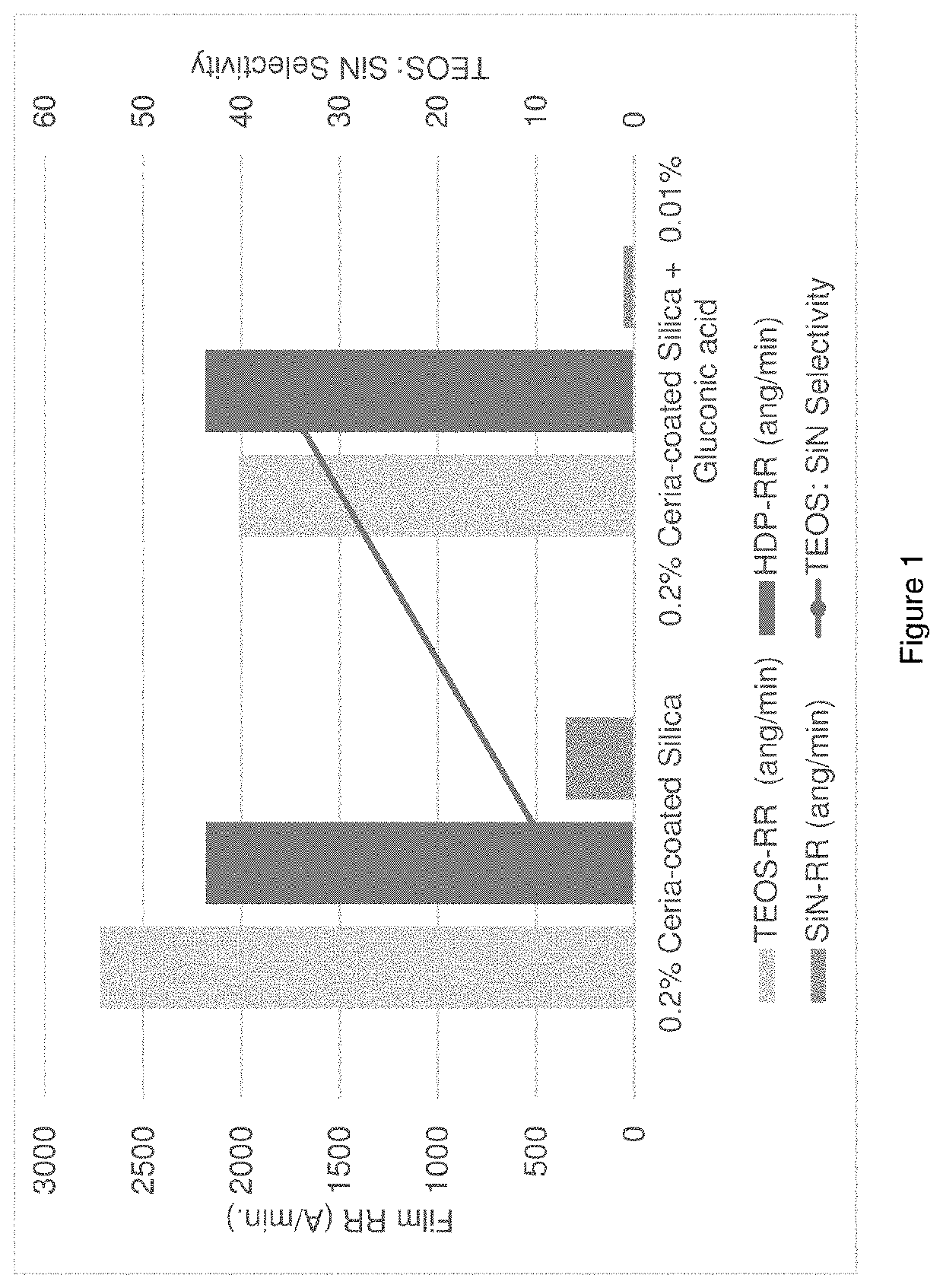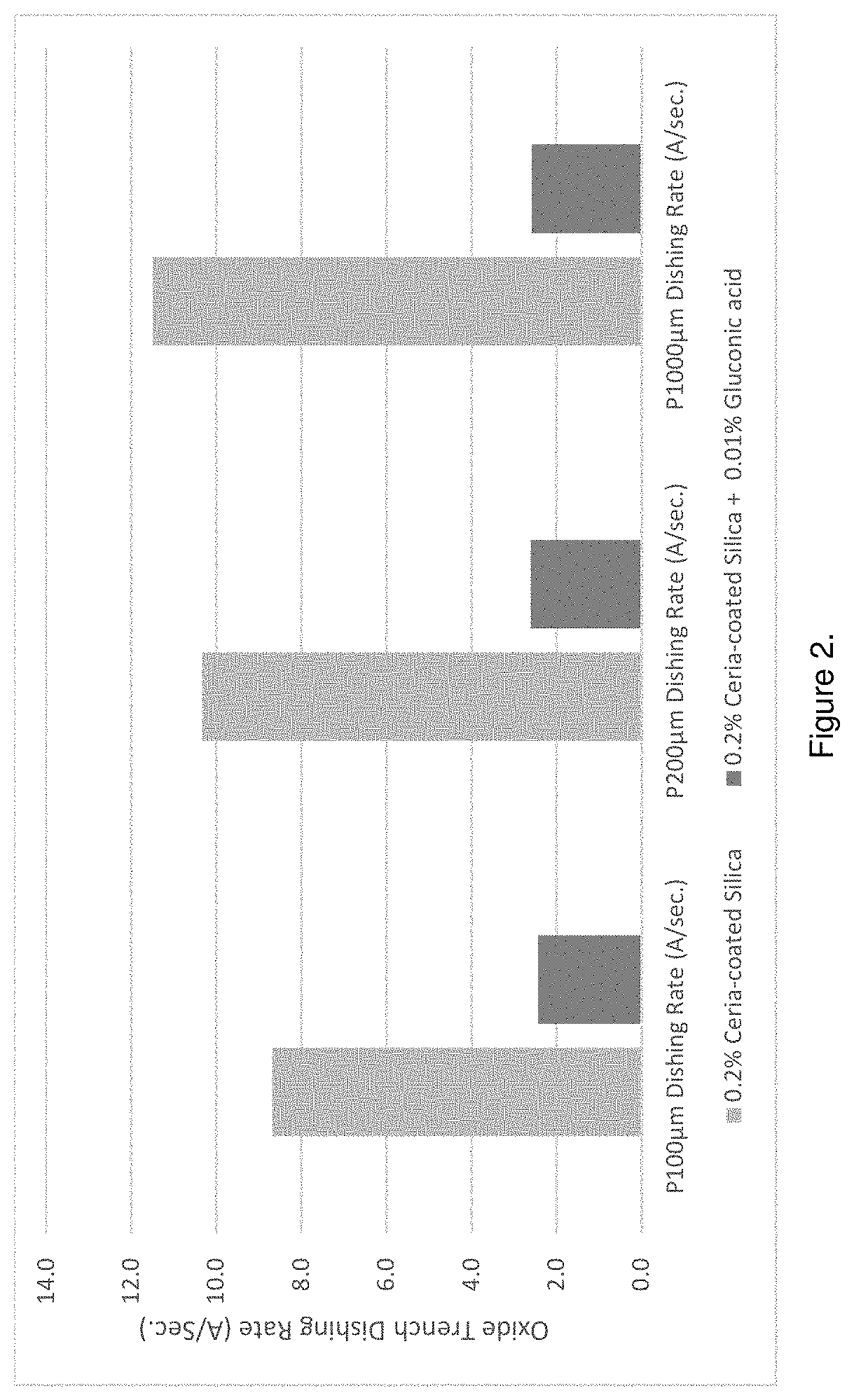High Oxide VS Nitride Selectivity, Low And Uniform Oxide Trench Dishing In Shallow Trench Isolation(STI) Chemical Mechanical Planarization Polishing(CMP)
- Summary
- Abstract
- Description
- Claims
- Application Information
AI Technical Summary
Benefits of technology
Problems solved by technology
Method used
Image
Examples
working examples
[0121]In the following working examples, a STI polishing composition comprising 0.2 wt. % cerium-coated silica, a biocide ranging from 0.0001 wt. % to 0.05 wt. %, and deionized water was prepared as reference (ref.).
[0122]The working polishing compositions were prepared with the reference (0.2 wt. % cerium-coated silica, a biocide ranging from 0.0001 wt. % to 0.05 wt. %, and deionized water) and a disclosed chemical additive in the range of 0.0025 wt. % to 0.015% wt. %.
example 1
[0123]In Example 1, the polishing compositions used were shown in Table 1. The reference sample was made using 0.2 wt. % ceria-coated silica plus very low concentration of biocide. The chemical additive, gluconic acid was used at 0.01 wt. %. Both samples have same pH values at around 5.35.
[0124]The removal rates (RR at A / min) for different films were tested. The effects of chemical additive gluconic acid on the film removal rates and selectivity were observed.
[0125]The test results were listed in Table 1 and shown in FIG. 1 respectively.
TABLE 1Effects of Gluconic Acid on Film RR (Å / min.) & TEOS:SiN SelectivityTEOS-RRHDP-RRSiN-RRTEOS:SiNCompositions(ang / min)(ang / min)(ang / min)Selectivity0.2% Ceria-coated Silica27182180349 8:10.2% Ceria-coated201521835636:1Silica + 0.01%Gluconic acid
[0126]As the results shown in Table 1 and FIG. 1, the addition of gluconic acid in the polishing composition effectively suppressed SiN removal rates while still afforded high TEOS and HDP film removal rate...
example 2
[0137]In Example 2, the polishing composition were prepared as shown in Table 5. The chemical additive gluconic acid were used at different wt. %. pH for the compositions was all around 5.35.
[0138]The various film polishing removal rates and TEOS: SiN selectivity results were listed in Table 5 and depicted in FIG. 7.
TABLE 5Effects of Gluconic Acid (GA) % on Film RR (Å / min.) & TEOS:SiN SelectivityTEOS-RHDP-R SiN-R TEOS:SiNCompositions(ang / min)(ang / min)(ang / min)Selectivity0.2% Ceria-coated Silica27182180349 8:10.2% Ceria-coated Silica + 0.0025% GA365536099339:10.2% Ceria-coated Silica + 0.005% GA287529326743:10.2% Ceria-coated Silica + 0.01% GA175417675333:10.2% Ceria-coated Silica + 0.015% GA185419145733:10.2% Ceria-coated Silica + 0.1% GA1109149 2:1
[0139]As the results shown in Table 5 and FIG. 7, all compositions with different concentrations of gluconic acid provided a stable suppressed SiN removal rates. All compositions except the composition with 0.1 wt. % gluconic acid still a...
PUM
| Property | Measurement | Unit |
|---|---|---|
| Acidity | aaaaa | aaaaa |
| Acidity | aaaaa | aaaaa |
| Acidity | aaaaa | aaaaa |
Abstract
Description
Claims
Application Information
 Login to View More
Login to View More - R&D
- Intellectual Property
- Life Sciences
- Materials
- Tech Scout
- Unparalleled Data Quality
- Higher Quality Content
- 60% Fewer Hallucinations
Browse by: Latest US Patents, China's latest patents, Technical Efficacy Thesaurus, Application Domain, Technology Topic, Popular Technical Reports.
© 2025 PatSnap. All rights reserved.Legal|Privacy policy|Modern Slavery Act Transparency Statement|Sitemap|About US| Contact US: help@patsnap.com



